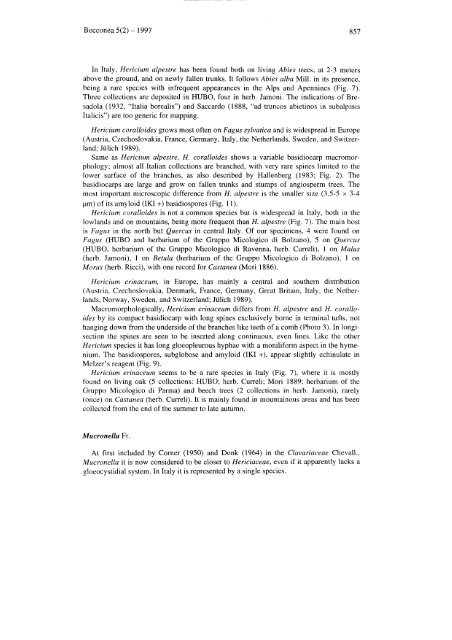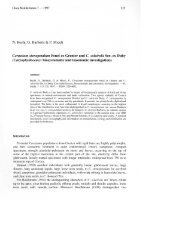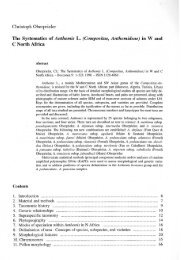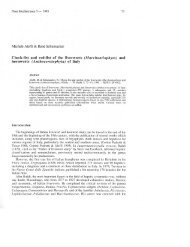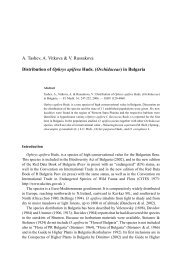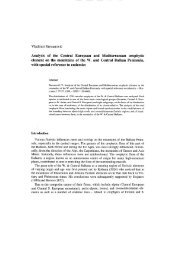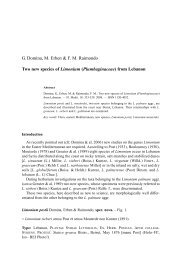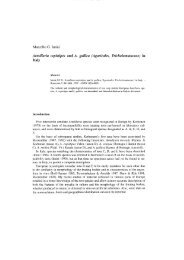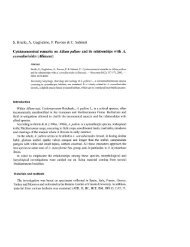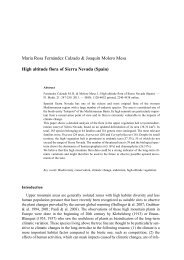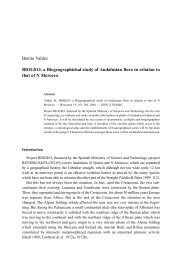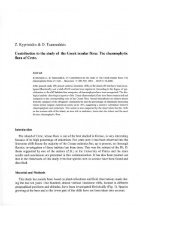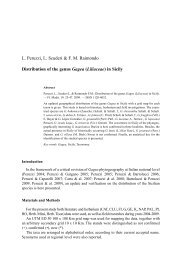Annarosa Bernicchia & Fabio Padovan Preliminary ... - Herbmedit.org
Annarosa Bernicchia & Fabio Padovan Preliminary ... - Herbmedit.org
Annarosa Bernicchia & Fabio Padovan Preliminary ... - Herbmedit.org
Create successful ePaper yourself
Turn your PDF publications into a flip-book with our unique Google optimized e-Paper software.
Bocconea 5(2) - 1997 857<br />
In Italy, Hericium alpestre has been found both on living Abies trees, at 2-3 meters<br />
above the ground, and on newly fallen trunks. It follows Abies alba Mill. in its presence,<br />
being a rare species with infrequent appearances in the Alps and Apennines (Fig. 7).<br />
Three collections are deposited in HUBO, four in herb. Jamoni. The indications of Bresadola<br />
(1932, "Italia borealis") and Saccardo (1888, "ad truncos abietinos in subalpinis<br />
Italicis") are too generic for mapping.<br />
Hericium coralloides grows most often on Fagus sylvatica and is widespread in Europe<br />
(Austria, Czechoslovakia, France, Germany, Italy, the Netherlands, Sweden, and Switzerland;<br />
Jiilich 1989).<br />
Same as Hericium alpestre, H. coralloides shows a variable basidiocarp macromorphology;<br />
almost all Italian collections are branched, with very rare spines limited to the<br />
lower surface of the branches, as also described by Hallenberg (1983; Fig. 2). The<br />
basidiocarps are large and grow on fallen trunks and stumps of angiosperm trees. The<br />
most important microscopic difference from H. alpestre is the smaller size (3.5-5 x 3-4<br />
flm) of its amy loid (IKI +) basidiospores (Fig. Il).<br />
Hericium coralloides is not a common species but is widespread in Italy, both in the<br />
lowlands and on mountains, being more frequent than H. alpestre (Fig. 7). The main host<br />
is Fagus in the north but Quercus in centraI Italy. Of our specimens, 4 were found on<br />
Fagus (HUBO and herbarium of the Gruppo Micologico di Bolzano), 5 on Quercus<br />
(HUBO, herbarium of the Gruppo Micologico di Ravenna, herb. Curreli), l on Malus<br />
(herb. Jamoni), l on Betula (herbarium of the Gruppo Micologico di Bolzano), 1 on<br />
Morus (herb. Ricci), with one record for Castanea (Mori 1886).<br />
Hericium erinaceum, in Europe, has mainly a centraI and southern distribution<br />
(Austria, Czechoslovakia, Denmark, France, Germany, Great Britain, Italy, the Netherlands,<br />
Norway, Sweden, and Switzerland; Jiilich 1989).<br />
Macromorphologically, Hericium erinaceum differs from H. alpestre and H. coralloides<br />
by its compact basidiocarp with long spines exc1usively borne in terminaI tufts, not<br />
hanging down from the underside of the branches like teeth of a comb (Photo 3). In longisection<br />
the spines are seen to be inserted along continuous, even lines. Like the other<br />
Hericium species it has long gloeopleurous hyphae with a moniliform aspect in the hymenium.<br />
The basidiospores, subglobose and amy loid (IKI +), appear slightly echinulate in<br />
Melzer's reagent (Fig. 9).<br />
Hericium erinaceum seems to be a rare species in ltaly (Fig. 7), where it is mostly<br />
found on living oak (5 collections: HUBO; herb. Curreli; Mori 1889; herbarium of the<br />
Gruppo Micologico di Parma) and beech trees (2 collections in herb. Jamoni), rarely<br />
(once) on Castanea (herb. Curreli). It is mainly found in mountainous areas and has been<br />
collected from the end of the summer to late autumn.<br />
Mucronella Fr.<br />
At first inc1uded by Corner (1950) and Donk (1964) in the Clavariaceae Chevall.,<br />
Mucronella it is now considered to be c10ser to Hericiaceae, even if it apparently lacks a<br />
gloeocystidial system. In Italy it is represented by a single species.


